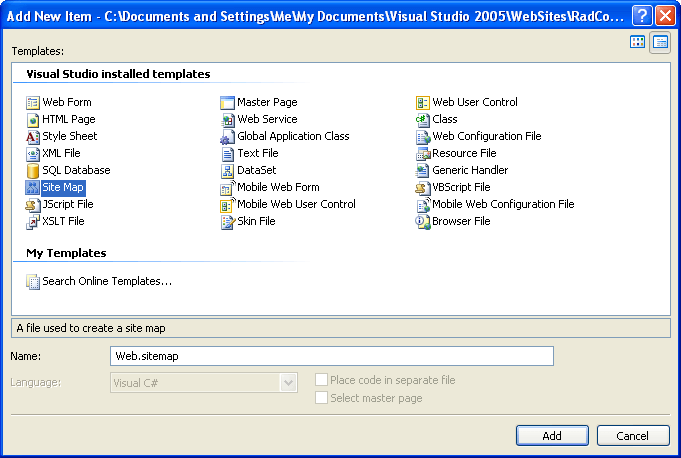Binding to SiteMapDataSource
Some data sources are inherently hierarchical. These include SiteMapDataSource and XmlDataSource. When data-bound to these types of data sources, RadSiteMap automatically creates the node hierarchy. There is no need to use the DataFieldID and DataFieldParentID properties.
Binding to SiteMapDataSource
When binding to SiteMapDataSource, there is no need to set any properties to map fields from the data source to properties of the nodes. This is because site maps have a strictly defined structure.
The SiteMapDataSource control defines the structure of your Web site. By default the SiteMapDataSource control uses the default Site Navigation Provider. This provider lets you define the structure of your site, separating the real page structure of the site on one hand, and the UI presentation on the other.
The default site navigation provider is XML-based. It should stay in the root level of your project and should be named web.sitemap. Using the Site Navigation API provided in ASP.NET v2.0, you can write your own Site Navigation Provider and expose the navigation information from any back-end system, if needed.
Setting the SiteMapDataSource control
Before adding the SiteMapDataSource control to your page, you need to add the Site Navigation Provider.
- In the Solution Explorer, choose Add New Item... In the templates dialog, select Site Map:

- Click the Add button. Visual Studio generates the web.sitemap file with the initial code:
<?xml version="1.0" encoding="utf-8" ?>
<sitemap xmlns="http://schemas.microsoft.com/AspNet/SiteMap-File-1.0">
<siteMapNode url="" title="" description="">
<siteMapNode url="" title="" description="" />
<siteMapNode url="" title="" description="" />
</siteMapNode>
</sitemap>
- Populate the Web.sitemap file. Here is an example:
<?xml version="1.0" encoding="utf-8" ?>
<sitemap xmlns="http://schemas.microsoft.com/AspNet/SiteMap-File-1.0">
<siteMapNode url="https://www.telerik.com" title="Telerik" description="Telerik home page">
<siteMapNode url="https://www.telerik.com/radcontrols" title="Telerik RadControls for ASP.NET" description="Telerik RadControls for ASP.NET" >
<siteMapNode url="https://www.telerik.com/radeditor" title="Telerik RadEditor" description="Telerik RadEditor control"/>
</siteMapNode>
<siteMapNode url="https://www.telerik.com/radnavigation" title="Telerik RadNavigation controls" description="Telerik RadNavigation controls" />
</siteMapNode>
</sitemap>
The url must be unique for each node. Avoid using backslashes (\) for your URLs. Backslashes may cause problems with some browsers. Instead, we use the slash character (/).
Drag a SiteMapDataSource instance from the Toolbox to your Web page.
Set the ShowStartingNode property of the SiteMapDataSource component to False. This allows you to use multiple menu items at the root level.
Binding RadSiteMap to SiteMapDataSource
From the RadSiteMap property pane, set the DataSourceID to the ID of the SiteMapDataSource control.
Each siteMapNode has three attributes which are mapped automatically to the respective properties:
url - Maps to the NavigateUrl property.The path can be either relative (using the ~/), or absolute.
title - Maps to the Text property.
description - Maps to the ToolTip property.
To set additional properties or overwrite already populated fields, use the NodeDataBound event. The example below overwrites the TooTip property with the Text value of the item and sets the Value property to a concatenated string of [Text] + [URL]:
protected void RadSiteMap1_NodeDataBound(object sender, Telerik.Web.UI.RadSiteMapNodeEventArgs e)
{
SiteMapNode sitemapNode = e.Node.DataItem as SiteMapNode;
e.Node.ToolTip = sitemapNode.Title + " - " + sitemapNode.Url ;
}
Protected Sub RadSiteMap1_NodeDataBound(ByVal sender As Object, ByVal e As Telerik.Web.UI.RadSiteMapNodeEventArgs)
Dim sitemapNode As SiteMapNode = TryCast(e.Node.DataItem, SiteMapNode)
e.Node.ToolTip = sitemapNode.Title + " - " + sitemapNode.Url
End Sub